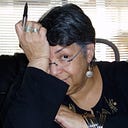“Do You Remember Love?” and “The Notebook”?:
Alzheimer’s Disease: The Longest Goodbye

“Our friend Dylan Thomas once told us: ‘Do not go gentle into that good night’. And my friends, I have tried to rage against the dying of the light. But now my rage is long since spent. Not squandered. Not even proudly laid upon the bar. But given up grudgingly to a dark, unseen creditor who drags me into the darkness for debts I do not remember…”
~ From a speech written by the lead character, Barbara Wyatt Hollis, in the award-winning 1985 television movie “Do You Remember Love?” starring JoAnne Woodward.
The recent revelation that two of the greatest actresses of my generation, JoAnne Woodward and Gena Rowlands, both 94 years old now, are victims of Alzheimer’s Disease was heartbreaking. In an additional bit of irony, they both had roles in movies in which they portrayed women stricken with the dreaded disease. Remarkably, both women had deeply personal connections to the subject matter covered in these two movies. In 1985, during promotional interviews for her film, JoAnne Woodward revealed that she was doing a one-woman juggling act and had to move Heaven and Earth to get her movie made. At the time, she also happened to be caring for her own mother, who had Alzheimer’s Disease. And years later, in 2022, it was revealed in the six-part docuseries, The Last Movie Stars, which chronicles the lives and careers of Paul Newman and JoAnne Woodward, that JoAnne had been diagnosed with Alzheimer’s Disease just a few days before her husband Paul Newman received a fatal diagnosis of terminal cancer, from which he died in 2008. Most recently, as relating to Gena Rowlands, who portrayed a woman with Alzheimer’s in The Notebook, her son, director, Nick Cassavetes, who directed her in the movie, revealed several more heartbreaking details. That his mother had been diagnosed with Alzheimer’s five years ago, and that her mother, his grandmother, Lady Rowlands, (1904–1999) had also been stricken with the disease. Cassavetes, the older child of Gena Rowlands and director John Cassavetes, said in recent interviews: “My mom is in full dementia…It’s so crazy — we lived it, she acted it, and now it’s on us…I got my mom to play older Allie, and we spent a lot of time talking about Alzheimer’s and wanting to be authentic with it, and now, for the last five years, she’s had Alzheimer’s…”
I find it very easy to understand and feel tremendous empathy for family members in these cases. These stories are personal to me as well. This dreaded disease has cut a brutal and indiscriminate swath through my family for generations. Long before there was even a name for it. And with few exceptions, the victims are all female. My mother was diagnosed in 1983, and her struggle continued until her death in 1992. Witnessing the heartbreak of her decline, missing the woman she had been, and reaching out to my father who single-handedly cared for her for many years, I expressed my emotions in an essay, Alzheimer’s Disease: The Longest Goodbye, in the employee newsletter, S.C.O.P.E. — A Medical Newsletter — Spring, 1990, at City of Hope National Medical Center in Duarte, California where I was employed at the time.
The fact that there is a 50/50 chance that Alzheimer’s Disease will continue to affect our family is a sad reality that we live with. But I also live with the hope that even though it will come too late to have helped my mother, a treatment and a cure will be discovered in my lifetime that will save all of the mothers and loved ones in the world who might be affected by this unrelenting disease. Even though millions of dollars have been allocated for research in recent years, young adult on-set cases are on the rise, and the need for more funding is crucial. In the years since my aunt finally succumbed to the ravages of this catastrophic disease, and since my mother was diagnosed, I have spent hours in medical libraries reading medical books, and countless hours collecting the latest studies in an attempt to keep current with what research is being performed. I have achieved an uneasy familiarity with stark, intimidating, medical phraseology such as: “Neuron Groups”, “Neurotransmitters”, “Cholinergic Cells”, “Basal Nuclear Breakdown”, and “Electrochemical Circuits”. Somewhere within this group of mysterious terms lies the answer to this frightful disease. And for those of us fifty-per centers who face the waiting abyss of the black hole, either as caregivers or as recipients standing in the line of genetic destiny, it is incumbent upon us to push for more millions for research, more pressure on Congress and Medicare for more nursing homes to care for our loved ones. The staggering costs of diagnosis, treatment and nursing home care continue to climb every day, but even the slightest possibility of a medical breakthrough in this Century is an end result that none of us can afford not to strive for.
